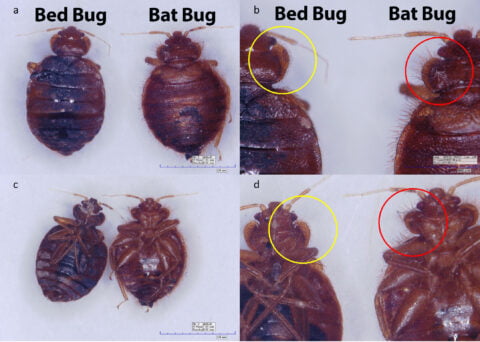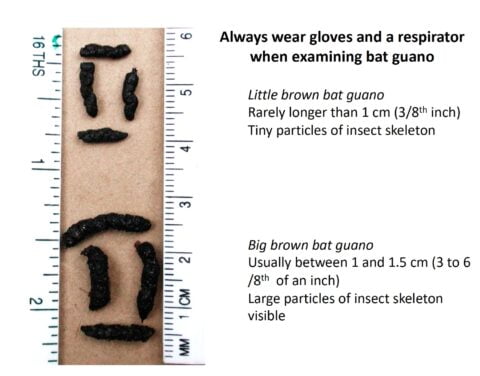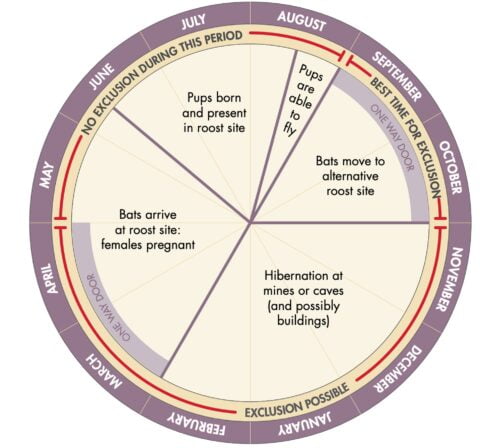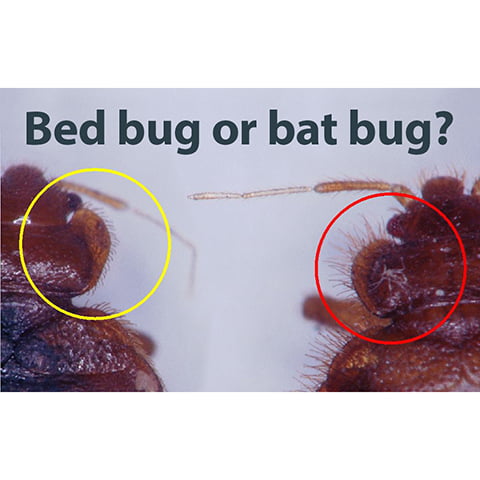EDITOR’S NOTE: ALWAYS CHECK WITH YOUR STATE BEFORE USING A PRODUCT FOR A PEST THAT IS NOT SPECIFICALLY LISTED ON THE LABEL. NOT ALL STATES PERMIT THE USE OF PRODUCTS UNDER FIFRA SECTION 2 (ee).
Background
Bat bugs (Cimex adjunctus) are often mistaken for bed bugs (Cimex lectularius L.), but correct identification is important for their management. Bat bugs can occasionally be found in homes, but they rarely feed on humans. Bat bugs enter homes if they become separated from their preferred host. This occurrence is common when bats find a suitable entrance into a property and establish a colony in areas such as attics, unused chimneys and wall voids. Bat bugs seek harborages close to their hosts, establishing themselves in cracks and crevices near to the roosting bats. Fortunately, bat bugs have not been shown to transmit disease to humans. However, if bats and bat bugs establish in a home, it is important to know how to correctly address the situation. This article will cover the important differences in treatment protocols for bat bugs as these differ to bed bug management.
Bat bug identification
The first step is to establish whether there are any indications that a report of ‘bed bugs’ may actually be bat bugs. The appearance of ‘bed’ bugs in odd locations, particularly when there is little or no evidence of an established population around beds and seating areas maybe the first indicator. If you come across this situation, collect any individuals that you find so that you can check them under appropriate magnification.
It is always good practice to have a detailed conversation with clients regarding their pest observations, but it’s particularly important when dealing with bed bugs and/or bat bugs. Ask the client where and when they first noticed the bugs. Check if they are aware of bats in or around the property. Often, bat bugs only appear inside the property after the bats have left or been excluded. Even homeowners who are aware that bats are, or had been roosting in their property may not be aware that bats may be responsible for introducing bat bugs into the home.
If bats are suspected, look for potential entry/exit points where bats may gain entry around the exterior of the home. Check for structural defects in soffits, siding, chimneys, basements and crawl spaces. Ask clients if they have heard scurrying or scratching sounds, or high-pitched squeaking, particularly around dawn or dusk.
To confirm that the specimen(s) that you collected are indeed bat bugs, a microscope or cell phone attachment with 20 to 50x magnification is required. Fortunately, there are some very cost-effective digital options now available. Some come with attached LCD screens and others can be connected to a computer or smart phone. Prices range from $30-100. Most will provide sufficient clarity to observe the main differences between bat bugs and bed bugs.
Figure 1 shows dorsal and ventral views of an adult bed bug (left) and an adult bat bug (right). There are a few subtle differences between the two, but the most reliable feature is the length of the hairs around the pronotum (behind the head). Bat bugs have long hairs, usually twice the length of the eye, whereas bed bugs have much shorter hairs. Bat bugs also have longer hairs around their entire abdomen.

Figure 1 Adult bed bug (left) and bat bug (right), showing dorsal view (a&b) and ventral view (c & d). Bed bugs have short hairs on their pronotum (yellow circle) bat bugs have long hairs on the pronotum (red circle). Note the hairs on the bat bug are longer than the width of the eye. Bat bugs also have longer hairs around their entire abdomen. (Photo credit: Nina Jenkins, Penn State University)
Bat bugs confirmed – what to do now?
Here’s where things can get a little complicated. Many species of bats are federally protected and there are restrictions on removal and exclusion of bats during specified times of the year. Each state has specific regulations, which are based on the population biology of the bats in their region. Table 1 (back page) found in the Field Notes document here, provides a useful a summary of the regulations for all states in the US, along with a link to the relevant state websites for verification. These restrictions are in place to protect the bat population from further decline, and the rules must be strictly followed. As a result, bat bug infestations may need to be managed in the home for a period of time before the bats can be legally excluded. The following sections will provide guidance on how to manage bat bugs inside homes during the restricted period, and treatment protocols for once bats have been excluded from the roost. We also cover basic information on bat exclusion and bat proofing to prevent the returning bats from re-establishing in the home. However, you may want to subcontract bat exclusion and proofing to a wildlife expert. States may allow exceptions for certain health and safety situations, such as when a rabid bat may be present.
Bat bug management while bats remain in the roost
If bat exclusion is not permitted, you can still provide services to manage bat bugs inside the home until exclusion can be implemented. Do not enter or treat the area where bats are roosting. Application of any product in the presence of bats is not permitted. Treatment of roosting sites can only be conducted after all bats have been permanently excluded from the roost. If you’re considering Aprehend for treatment of bat bugs, note that not all states permit the use of products under FIFRA section 2 (ee). Always check with your state before using a product for a pest that is not specifically listed on the label.
Bat bug management must be focused inside the home while bats are present in the roost. First try to establish where the bats are roosting and identify the potential route(s) that bat bugs are using to enter the home. Discuss sightings with clients to determine the room or rooms where bat bugs were seen. Check light fixtures, vents, plumbing chases, chimneys, windows, window casings, vents, and other potential access points leading from wall voids or attics. If there are visible structural defects that provide bugs easy access from the roosting area, these should be sealed using appropriate materials. If this is beyond the scope of work for a PMP, advise the client to arrange appropriate repairs.
In most situations, bat bugs are found as single roaming bugs. However, if bat bug harborages are found in the home, use a vacuum to remove them. Next, apply Aprehend barriers around all suspected access points between the roosting bats and the home. While Aprehend cannot prevent bat bugs from entering, it will ensure that bat bugs acquire the fungal spores on entry to the home and will die soon after entry.
Additional Aprehend barriers may be placed around beds and seating areas using the same strategy as for bed bugs. This will ensure that bat bugs attempting to gain a blood meal will pick up spores and similarly will not establish harborages close to the human host.
Aprehend barriers remain effective for up to 3 months, so providing all potential access points and areas where humans are sedentary have been treated, this single application should be sufficient to protect the home and provide peace of mind for the client until exclusion of the bats is legally permitted. A second application is recommended following exclusion of the bats to refresh the barriers. Once the bats have left, any remaining bat bugs are likely gain entry into the residence in their attempt to seek a suitable host. Aprehend barriers will prevent these bugs from establishing in the home. Use of an insecticidal dust product inside the roost after exclusion will also help to minimize the number of bat bugs attempting to enter the house.
Bat exclusion
Details on constructing one-way bat doors for exclusion can be found on the Bat Conservation International website and/or Bat World Sanctuary. Ensure this is only conducted when permitted by state regulations. Consult Table 1 (back page) found in the Field Notes document here. Generally, exclusion is not permitted during spring and summer, as this is when maternity colonies are present. These colonies may contain large numbers of pups. The pups cannot fly, so they remain in the roost while adults leave at dusk to forage. Exclusion should only be implemented once the pups have fully fledged and are not dependent on the roost for harborage. This usually occurs in late summer/early fall. In late fall, some species of bats (e.g. the big brown bat) use structures to hibernate through the winter. In states where big brown bat populations are known to be present, bat proofing is also prohibited or discouraged from November through March. If you receive a call for bat bugs or bats between November and March, hibernating big brown bats may well be the problem.
It is possible to identify bats by their guano. Figure 2, shows the difference in size and appearance of guano from little brown and big brown bats. If you suspect big brown bats, contact your state wildlife management team for advice. In most regions of the US, young bats begin leaving the roost for foraging with the adults around July. Generally, bat exclusion and bat proofing is permitted from the end of August, though October. In states where big brown bats are known to hibernate in structures, bat proofing is generally permitted again in early spring from April to May prior to maternity season (Figure 3). Again, for accurate information on your state, refer to Table 1 (back page) found in the Field Notes document here to check for any changes or updates to this information since publication of this guide.

Figure 2 Guano from little brown bat (above) and big brown bat (below), showing size difference and typical irregular shape of bat guano. (Photo credit: Cal Butchkoski, PA Game Commission)

Figure 3 General calendar guide for bat activity in North America. IMPORTANT – consult Table 1 (back page) found in the Field Notes document here for information and links to specific to your state before commencing any bat exclusion or bat proofing activities. (Graphic credit: Canadian Wildlife Federation)
Bat exclusion and proofing is a process and cannot be achieved on a single visit. The first step is to identify the entry and exit points being used. Common entrance areas include chimneys, vents, soffits, joists, and corners. Check for holes with staining and/or guano (bat droppings). The presence of guano on walls, floors, or the ground usually indicates an entrance is present somewhere above. It is helpful to observe bat activity at dusk. Watch potential ports of entry to see where bats are exiting the building. It may also be helpful to count the number of bats exiting to determine the size of the colony. Once you have identified the exit/entrance locations, cover each with a one-way bat exclusion device. These devices allow bats to leave naturally for foraging, but prevent their return to the roost. Seal up any potential/alternative entryways. It is important to note that not all bats leave the roost every evening, so it is recommended that one-way doors are left in place for at least 7 days of conducive bat foraging weather (warm temperatures, low rainfall, low wind conditions) before moving to seal up the access points completely. Cooperation from the resident may be required to verify that bats are not regaining access elsewhere in the structure.
Clean-up and bat bug eradication once bats have been excluded
Once you have verified that all the bats have left, guano should be carefully removed. Always wear a respirator when dealing with bat guano as it is known to carry spores of Histoplasma, a fungus that causes histoplasmosis if inhaled. If using a vacuum, ensure that it is fitted with a HEPA filter. After removing all accessible guano, apply an insecticidal dust product inside the void where the bats were roosting. If you have access to the space, e.g. an attic, be sure to carefully dust between cracks and crevices of all accessible boards and rafters. Where bats have been roosting in smaller, inaccessible voids use a power duster to get good coverage inside the void. Following the insecticidal dust application, seal the main access point to ensure that bats cannot return to the roost. Finally, application of Aprehend should be conducted inside the house. This is important even if Aprehend was applied earlier when bats were still in the roost, since any bat bugs that were not affected by the dust treatment will start looking for hosts in the absence of their usual food source. Follow up after 30 days after treatment to ensure that there are no further bat bug sightings.
Be sure to check out the ConidioTecTips and training videos on the Aprehend channel. You’ll find information on strategic barrier placement, customer prep and education, even bed bug biology.
And find out more about how Aprehend can help you win the fight against bed bugs – check out the PMP Case Studies and Protocols or give us a call at (800) 891-8610.
Resources:
Bat Bugs: Management of bat bugs and their hosts Field Notes (ConidioTec)
National Wildlife Control Operator’s Association (NWCOA)
Wildlife Control Business Builders (WCBB)

